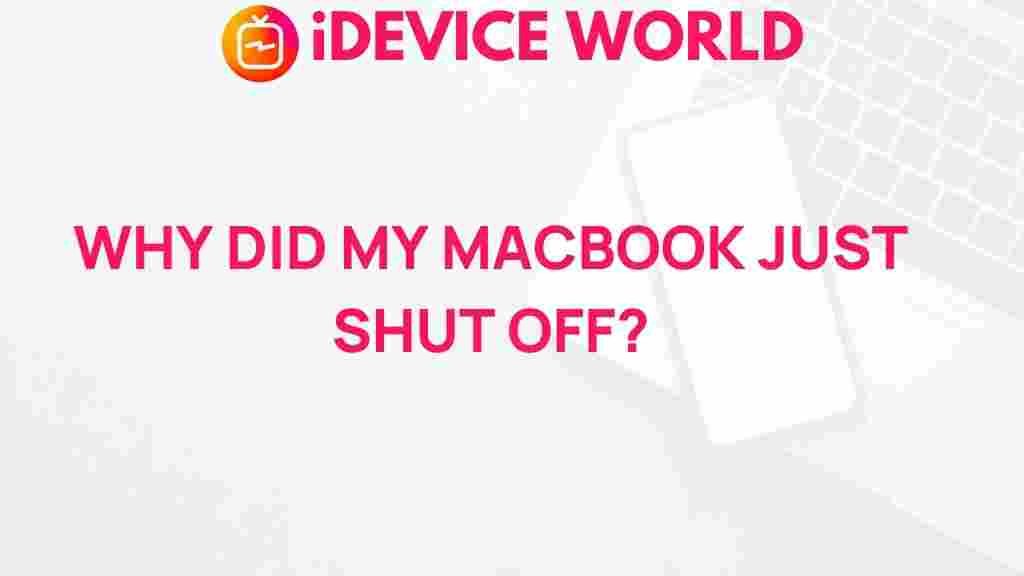Unraveling the Mystery of Unexpected MacBook Shutdowns
Unexpected shutdowns can be a frustrating experience for any MacBook user. Whether you’re working on an important project, enjoying a movie, or engaging in a video call, having your device shut down unexpectedly can lead to lost work and productivity. In this article, we will explore the potential causes of these sudden shutdowns, offer troubleshooting tips, and guide you on how to prevent this issue from occurring in the future.
Understanding Your MacBook’s Shutdown Behavior
Before diving into the troubleshooting process, it’s essential to understand why your MacBook may shut down unexpectedly. A variety of factors can contribute to this issue, including:
- Hardware Malfunctions: Issues with hardware components such as the battery, logic board, or overheating can cause your MacBook to shut down.
- Software Conflicts: Outdated or incompatible software may lead to system instability, resulting in unexpected shutdowns.
- Operating System Issues: Corrupted system files or bugs within the macOS can trigger sudden restarts or shutdowns.
- Power Supply Problems: A failing power adapter or issues with the electrical supply can also lead to unexpected behavior.
Step-by-Step Process to Diagnose Unexpected Shutdowns
If your MacBook has been shutting down unexpectedly, follow these steps to diagnose the problem:
1. Check for Overheating
Overheating is one of the primary causes of unexpected shutdowns. To check if your MacBook is overheating, monitor its temperature. You can use apps like iStat Menus to view the temperature of various components. If your device is running hot, consider the following:
- Ensure that air vents are not blocked.
- Use your MacBook on a hard, flat surface to enhance airflow.
- Close unnecessary applications that may be consuming resources.
2. Inspect the Battery Health
Battery health plays a crucial role in your MacBook’s performance. A failing battery can cause your MacBook to shut down unexpectedly. Check your battery health by following these steps:
- Click on the Apple menu and select About This Mac.
- Choose System Report and then click on Power.
- Look for the Cycle Count and Condition of your battery.
If your battery condition is listed as Replace Soon or Service Battery, it may be time to consider a replacement.
3. Check for Software Updates
Running outdated software can lead to instability in your MacBook. To ensure your system is up to date:
- Go to the Apple menu and select System Preferences.
- Click on Software Update and install any available updates.
4. Review System Logs
Examining system logs can provide insights into what may have caused the unexpected shutdown. To access system logs:
- Open Console from the Applications > Utilities folder.
- Look for entries labeled Shutdown or Crash around the time of the unexpected shutdown.
This information may help identify the root cause of the issue.
5. Reset the SMC and PRAM
Resetting the System Management Controller (SMC) and Parameter RAM (PRAM) can resolve various power-related issues. Here’s how:
- To reset the SMC:
- Shut down your MacBook.
- Press and hold the Shift + Control + Option keys on the left side and the power button for 10 seconds.
- Release all keys and turn on your MacBook.
- To reset the PRAM:
- Shut down your MacBook.
- Turn it on and immediately press and hold Command + Option + P + R keys.
- Hold the keys for about 20 seconds, then release them.
Troubleshooting Tips for Persistent Issues
If your MacBook continues to shut down unexpectedly after performing the above checks, consider the following troubleshooting tips:
- Run Apple Diagnostics: This built-in tool checks for hardware issues. Restart your MacBook and hold the D key to initiate the diagnostics.
- Check for Malware: Although macOS is relatively secure, malware can still affect performance. Use reliable antivirus software to scan your system.
- Create a New User Account: Sometimes, user account issues can cause shutdowns. Create a new user account and see if the problem persists.
- Reinstall macOS: If all else fails, reinstalling the operating system can help fix corrupted files that may be causing the issue.
When to Seek Professional Help
If you have tried all the above steps and your MacBook still experiences unexpected shutdowns, it may be time to consult a professional. Here are some signs that indicate the need for expert help:
- Persistent shutdowns after troubleshooting.
- Physical damage to the MacBook, such as a cracked screen or water damage.
- Warning signs from system logs that suggest hardware failure.
Taking your MacBook to an Apple Store or authorized service provider can provide you with a diagnosis and potential solutions to get your device back in working order.
Preventive Measures to Avoid Unexpected Shutdowns
While you cannot completely eliminate the possibility of unexpected shutdowns, there are preventive measures you can take to reduce their frequency:
- Regular Maintenance: Keep your macOS updated, clean up disk space, and uninstall unused applications to maintain optimal performance.
- Monitor Battery Health: Keep an eye on your battery’s health and replace it if it shows signs of deterioration.
- Use a Surge Protector: Protect your MacBook from power surges that can damage its components.
- Backup Regularly: Use Time Machine or another backup solution to keep your data safe in case of sudden shutdowns.
Conclusion
Unexpected shutdowns on your MacBook can be a significant inconvenience, but understanding the potential causes and implementing the troubleshooting tips outlined in this article can help you address the issue effectively. Remember to perform regular maintenance, monitor your battery health, and seek professional assistance when needed. By taking proactive measures, you can enjoy a smoother and more reliable MacBook experience.
If you found this guide helpful, consider checking out more tips on MacBook optimization techniques to enhance your device’s performance. For further insights into macOS updates, visit the official Apple website.
This article is in the category Reviews and created by iDeciveWorld Team
